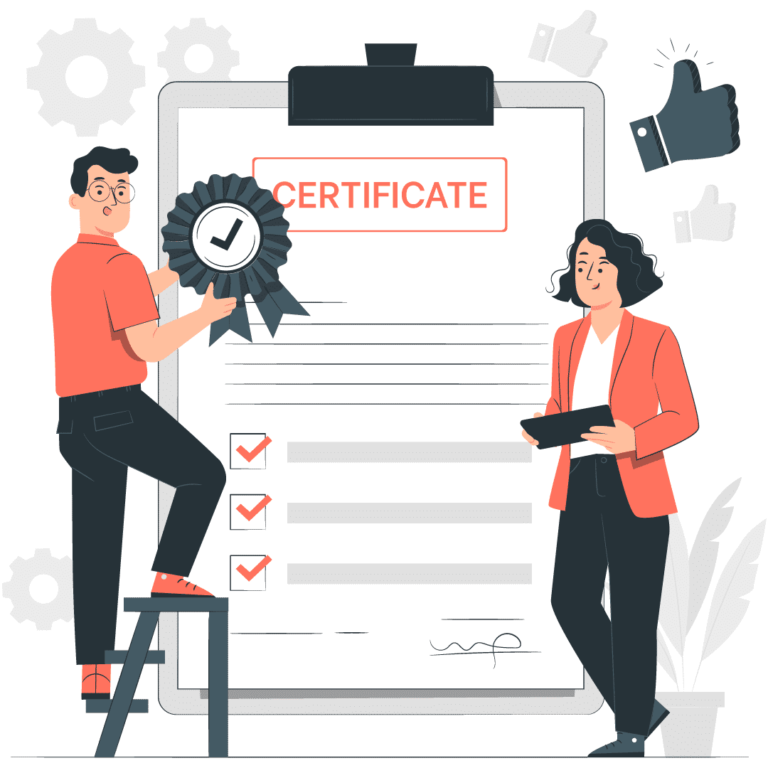Let’s imagine you’re in a job interview for the post of GRC Risk Analyst. The hiring manager asks, “How do you ensure alignment between an organization’s goals and its compliance and risk management strategies?”
Your mind stops and is unable to generate an answer. You know the theory, but how should you turn your knowledge into confidence? You’re not alone. If you’re entering the Governance, Risks and compliance world then you must keep in mind the interviews in this field can be complex, technical and dynamic.
In this blog, we will have a quick overview of the Top 50 GRC Interview Questions and Answers in 2025 to help you boost your confidence and help you get familiar with GRC interview Questions. So, let’s dive in and explore some amazing questions with their answers that will help you enter the GRC world!. Recruiters aim for those candidates who understand compliance frameworks, risk assessment and internal controls.
Here are some 50 questions to help you prepare for the GRC interview:
GRC Basics- Top Foundational GRC Questions– Q1–Q10
When giving an interview you must be prepared for any kind of questions e.g., some maybe just the theory or some questions will show your skills and practical knowledge about that topic, or few might describe your behaviour with the team. So, when we talk about the GRC basics, then it shows your understanding of GRC Fundamentals.
Here are some basic questions:
Q1) What is meant by GRC and why is it important?
Ans) GRC (Governance, Risk, and Compliance) refers to a strategic framework to manage governance, risks while maintaining compliance with government laws.
Q2) What are the Key Components of Governance, Risk, and Compliance?
Ans) Key components are:
Governance: It establishes leadership, roles, different policies and controls.
Risk management: It identifies, assesses, and alleviates the threat.
Compliance: It follows the rules and internal guidelines.
Q3) What does GRC Lifecycle and Process includes?
Ans) The GRC lifecycle includes planning, identifying risks, implementing controls, monitoring, and improving.
Q4) Differentiate between a risk assessment and a risk analysis.
Ans) Risk assessment finds and ranks the risks, whereas Risk Analysts examine how likely and how bad the risks are.
Q5) What is the role of internal audit in GRC?
Ans) This checks whether the GRC policies are working and helps them to improve.
Q6) What are some risk mitigation strategies?
Ans) Some common strategies are avoiding risk, mitigates the impact transferring the risk or accepting it.
Q7) What are some common compliance frameworks?
Ans) The examples of compliance framework are: GDPR, HIPAA, SOX, ISO 27001, PCI-DSS.
Q8) What is the difference between a policy and a procedure?
Ans) A policy is the rule or the regulation whereas, a procedure is a step-by-step way to follow those rules.
Q9) How do you use GRC tools to manage risks and compliance?
Ans) GRC tools help track risks, ensure compliance, and report issues.
Q10) What is a risk heat map?
Ans) A risk heat map is a colorful chart that depicts how likely a risk is and how big its impact is? This helps in finding the most serious risks in no time.
Governance Interview Questions
Q11–Q20: Governance in Corporate Structure
Q11) What is corporate governance?
Ans) Corporate Governance refers to how a firm is directed and controlled to meet their goals and stay moral.
Q12) How does governance support organizational objectives?
Ans) Governance helps us to set clear rules and regulations and checks if the company is on track and accountable.
Q13) What is the role of board of directors in governance?
Ans) The boards set company’s goals, supervise, and protects collaborators interests.
Q14) What are the benefits of a governance framework?
Ans) A governance framework improves decision-making, trust, compliance and risk control.
Q15) How do you ensure effective governance in an organisation?
Ans) You must use clear policies, strong leadership, regular checks and open communication.
Q16) Explain your experience with implementing or enhancing corporate governance practices.
Ans) So, I helped to set up some clear rules and regulations, professional staff and tracked the progress to improve the company’s governance. (You can personalize this.)
Q17) How do you stay well-informed about the increasing trends and best practices in corporate governance?
Ans) I explore various blogs, stay connected with the news, webinar and updates from governance bodies like OECD or ICSA.
Q18) Explain the key components of a corporate governance structure.
Ans) Key components are:
- Board of Directors
- Policies
- Internal Controls
- Reporting
- Accountability systems
Q19) How do you measure the effectiveness of corporate governance?
Ans) I measure the effectiveness of corporate governance by checking board performance, compliance rates, audit and the stakeholders report.
Q20) How do you handle conflicts of interest in a corporate governance?
Ans) I handle conflicts of interest by setting up clear rules, disclose conflicts early, and keep my decisions fair and transparent.
(The answers may vary according to your experience.)
Risk Management Interview Questions
Q21–Q30: Identifying and Managing Risk
Q21) What is risk management in GRC?
Ans) Risk management refers to finding, assessing, and mitigating the risks so that a company can meet its goals.
Q22) What is risk register and why is it important?
Ans) A risk register includes all known risks, their impact, and actions. It helps us to track and manage them in a correct way.
Q23) Explain difference between inherent and residual risk?
Ans) Inherent risk: is the risk before controls.
Residual risk: is what remains after controls are applied.
Q24) What are Key Risk Indicators (KRIs)?
Ans) Key Risk Indicators are the warning signs that show if the risk is increasing, helping the team to act before the problem increases.
Q25) How would you define risk appetite in a firm?
Ans) Risk appetite is how much risk a company is willing to take to reach its goals or objectives.
Q26) What steps are included in risk assessment interview?
Ans) You must identify risks, ask about their impact and likelihood, afterwards discuss ways to reduce or accept them.
Q27) What are some emerging risk trends in 2025?
Ans) Some issues like Cybersecurity threats, climate risks, and ESG (Environmental, Social, Governance) are growing concerns.
Q28) How can you use risk indicators to manage risk better?
Ans) I track indicators to find out the rising risks and take action before they turn into a serious situation.
Q29) What is risk mitigation?
Ans) Risk mitigation refers to taking action to mitigate the chance or effect of a risk.
Q30) How can you ensure compliance in a risk compliance interview?
Ans) By checking if rules are followed, reviewing past actions, and ensuring proper risk controls.
Compliance Interview Questions
Q31–Q40: Regulatory and Legal Compliance
Q31) What is regulatory compliance and why is it important?
Ans) Regulatory compliance means following rules and regulations such as GDPR or SOX. It helps and avoid mistakes and build trust.
Q32) How can you design a compliance program?
Ans) You must start with risk analysis, set policies, train staff, monitor regularly, and review for more improvements.
Q33) What are some common compliance interview questions asked?
Ans) The recruiters often ask about your knowledge of rules, handling audits, writing policies, and managing risks.
Q34) What do you understand by data privacy compliance?
Ans) Data privacy compliance means protecting personal data as per laws like GDPR to keep user’s information confidential.
Q35) What does compliance management means?
Ans) It is the process of planning, tracing and ensuring the organisation follows legal and policy rules.
Q36) What are some major regulations in compliance?
Ans) These include GDPR (EU), SOX (US), HIPAA (health data), and PCI DSS (payment security).
Q37) How do you deal with non-compliance issues?
Ans) I investigate, report, fix the main problem, and train people to prevent it again.
Q38) How do you stay updated on compliance trends?
Ans) I follow legal updates, read compliance blogs, attend different webinars, and join professional forums.
Q39) What happens during a regulatory audit?
Ans) Auditors check if we follow rules. We show documents, systems and fix gaps.
Q40) How can you handle audit compliance in your organization?
Ans) We prepare by keeping records, updating controls, and fixing any issues before audits happen.
GRC Tools, Software & Automation
Q41–Q45: Technology in GRC
Q41) What is GRC software tools?
Ans) GRC software tools help you to manage governance, risks, compliance in one system for better control.
Q42) What is ServiceNow GRC and how does it help?
Ans) ServiceNow GRC automates risk and compliance tasks, helps in making workflows faster and easier to track.
Q43) What are the benefits of using automated GRC?
Ans) Automated GRC alleviate the errors, saves time, and ensure faster response to risks and audits.
Q44) How is AI in GRC improving risk management?
Ans) AI in GRC predicts risks, flags issues, and improves decision-making through smart data analysis.
Q45) What GRC technology trends should we watch in 2025?
Ans) AI, machine learning, real-time risk monitoring, and automated audits are key trends in GRC technology.
Scenario-Based and Behavioral GRC Questions
Q46–Q50: Practical & Situational Interview Questions
Q46) Explain me about a time you handled a regulatory breach.
Ans) We found a GRDPR breach, reported it as fast as possible, fixed the issue, and updated controls. I learned a real life GRC challenge.
Q47) Describe a scenario where compliance clashed with business goals.
Ans) We postpended a product launch to meet compliance rules. We balanced both- this helps us to avoid bigger risk.
Q48) How do you explain risk to senior leadership?
Ans) I use clear and simple language, visuals, and business impact examples to make risks clear and urgent.
Q49) How do you approach scenario-based questions in GRC interviews?
Ans) I mostly use STAR method (Situation, Task, Action, Result) to explain my real actions and results clearly.
Q50) Give an example of your GRC experience in solving a problem?
Ans) As soon as I built a risk register for a new system and flagged gaps early- a good GRC experience example.
Conclusion
In conclusion, this GRC interview guide will provide you a clear vision of what to expect- from key concepts to real-life questions and answers. If you’re a beginner or growing your career in GRC, staying prepared with the updated GRC practices and trends such as AI, automation, and compliance changes is key. You must practice and focus on your way of giving responses and explore the updated GRC Q&A 2025 to boost your confidence. So, be confident You got this! Your journey in GRC is just getting started!





No comment yet, add your voice below!